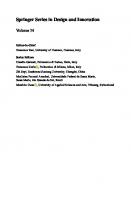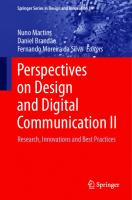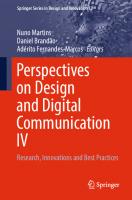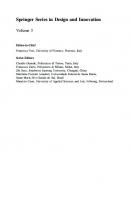Perspectives on Design III: Research, Education and Practice (Springer Series in Design and Innovation, 34) 303143515X, 9783031435157
This book reports on interdisciplinary research and practices in communication, fashion, product, and interior design, h
144 36 14MB
English Pages 389 [378] Year 2024
Table of contents :
Preface
Contents
Communication Design and Design Education as a Catalyst for Change
Youth Participation in Local Governance: Co-designing in the Democracy Reloading Initiative
1 Introduction
2 Democracy Reloading Approach
2.1 Background
2.2 Methodology
2.3 Stakeholders’ Engagement
2.4 Scaling Up, Out and Deep
3 Four Cases of Democracy Co-design
3.1 Co-design in Democracy Practice in Lister, Norway
3.2 Co-design in Democracy Practice in Flanders, Belgium
3.3 Co-design in Democracy Practice in Wallonia, Belgium
3.4 Co-design in Democracy in Portugal
4 Conclusions
5 Future Work
References
Speculative Interactions: Educational Contribution for Hypothetical Design Practice
1 Introduction
2 Design Areas for Speculative Proposals
3 Interaction Design Education at the Crossroad of Design and Research
4 Teaching Plan for What Is Yet Unmade
4.1 Interaction Design Master’s Degree and Interaction Project Units
4.2 Setting the Stage
4.3 Briefings and Work Phases
4.4 Difficulties and Limitations
5 Proposals as Case Studies
5.1 Proposal #1
5.2 Proposal #2
5.3 Proposal #3
6 Discussion
6.1 Interactions as Speculative Proposals
6.2 SCD Approach
6.3 Teaching Plan of What Was Made
7 Conclusions
References
What Should Be Known About Design if We Only Know Design?
1 Introduction and Main Concepts
1.1 Inter- and Transdisciplinary Concepts and Approaches
1.2 Porous Liquids Materials: Is It Interdisciplinary?
2 Research Method and the Case Studies Information
3 Analyzing Interdisciplinary
4 Conclusion or What Should Be Known About Design if We Only Know Design?
References
Sustainable Artistic Practices in Graphic Design for Visual Communication
1 Introduction
1.1 Critical Analysis of the Interaction Between Graphic Design and Industry
1.2 Expressive and Artistic Means of Graphic Design for Communication
2 Conclusion
References
Waste Management: Designing a User-Centered and Sustainable Mobile Application
1 Introduction
2 Literature Review
2.1 Gestalt Principles
2.2 Nielsen's Heuristics
2.3 User-Centered Design
2.4 Information Architecture
2.5 Human–Computer Interaction
2.6 Sustainable Web Design
3 Methodologies
3.1 Sustainable Web Design
3.2 Mobile App Development
4 Conclusion and Future Work
References
Building Bridges Between University and Responsible Practices in Design: A Case Study on a Campaign Against Dating Violence
1 Introduction
2 Contextualization of the Issue
3 Design and Social Responsibility
4 Methodology
4.1 Process and Development
4.2 Evaluation in an Academic Context and with APAV
4.3 Implementation and Publication
5 The Original Campaign and the Implemented Campaign
5.1 The Original Campaign
5.2 Implemented Campaign on Social Media
6 Results
7 Conclusions
References
The Contribution of Interface Design on the Promotion and Sales of Social Institutions’ Products: The Case Study of Escola Oficina
1 Introduction
2 Interface Design
3 E-commerce Interface Design
3.1 Aesthetics and Design
3.2 The Virtual Atmosphere
3.3 Usability
4 Purchase Intention in the Digital Environment
4.1 Design’s Influence in the Purchasing Intent
4.2 The Negative Online Shopping Experience
5 EO’s Online Store Development
5.1 Personas
5.2 Information Architecture
5.3 Wireframes and User Flows
5.4 Prototyping
5.5 Usability Testing
6 Conclusions and Future Work
References
Participatory Design and UX Research Methods, Using Interdisciplinary Knowledge From Design, Pedagogy and Nutrition to Promote Food Literacy in Children
1 Introduction
2 Interdisciplinary Considerations: Design, Pedagogy, Food and Nutrition
3 Participatory Design and UX Research Methods
3.1 Step 1—Creating Design Cards About the FLC
3.2 Step 2—Application of the Design Cards According to Participatory Design Principles and Analysis of the Described Results
3.3 Step 3—AEIOU Framework
3.4 Step 4—Personas, Empathy Maps, and Usage Scenarios
3.5 Step 5—User Journey Map
3.6 Step 6—Analogue Game Requirements
3.7 Step 7—Product Design Sketching
4 Conclusions
References
From Swiss Modernism to the International Compliant Style: Grids and Graphic Design in the Age of Information Disorder
1 Introduction
2 What is the International Compliant Style?
3 The Development and Dissemination of the IC-Style
3.1 The Style and Ideologies of Swiss Modernism
3.2 The Crucible of the Early Web: Technological Limitations and Standards, Economic Concerns and the Ideology of Functionalist Design
3.3 The Dissemination of the IC-Style: The Role of Web Templates
3.4 The Remediation of Modernism: From Swiss Grids to the IC-Style
4 The IC-Style in the Age of Information Disorder: Newspaper Design and Online Mis/Disinformation
4.1 Modernist Newspaper Design: Aesthetics of Authority and Credibility
4.2 The IC-Style’s Application Under Contemporary Commercial Platform Logics
5 The IC-Style and the Web Environment of Information Disorder: Case Studies
5.1 The “Non-Professional” Post-Factual News Website
5.2 Case Study: World Politicus
5.3 Case Study: Worldnewsdailyreport.com
6 Tackling Online Information Disorder: The Role of Design
6.1 Media Studies, Communication Design and the Future of Online Information
7 Conclusion
References
Typography: The Legacy of Manuel Pereira da Silva
1 Introduction
2 Background
3 Approach
4 Outputs
5 Conclusion
References
The Non-fiction Installation as a Form of Being-With
1 Introduction
1.1 Immersive Multimedia?
1.2 From the Museo Kircherianum to VR and XR
1.3 The Technical Image and How It Places Us in the World
1.4 Engaging with the Audience
2 The Non-fiction Installation and the Documentary
2.1 The Forms of Documentary and Testimony
2.2 Testimony in the Nonfiction Installation
2.3 From the Other Side
2.4 My Head Is My Only House, Unless It Rains
3 Conclusion
References
Fashion Design and Product Design for Sustainability and Collaboration
Empowering Imagination in Design Practice: Focus on Knitwear Design
1 Introduction
2 Thinking Through the Imagination
3 Design, Creativity and Imagination
4 Knitting, Design, and Imagination Tools: 3D Prototyping as a Challenge for the Future
4.1 Knitwear Beyond Fashion
5 Conclusions
References
Strategy for Observing Trends: A Tool for Developing Analytical and Critical Skills of Fashion Designers
1 Introduction
2 Literature Review
2.1 The Fashion Design Practice from Modernity to Post-Industrial Era
2.2 Trends, Culture and Fashion Consumption
2.3 Trends as a Tool for Developing Fashion Designer’s Analytical and Critical Skills
3 Methodology
3.1 Trend Observation Strategy to Be Used by Fashion Designers
3.2 The Trends Observation Workshop
4 Findings
4.1 Diagnostic Questionnaire
4.2 Evaluation Questionnaire
5 Considerations
References
Concepts and Material Futures in Fashion and Textile
1 Introduction
2 Humans and Nature
3 The Intertwined “Couture Vivant” for Fashion
4 Reverse Matter Design
4.1 Biodesign/“Couture Vivant” for Fashion
4.2 Subframe Studio
4.3 Rosie Broadhead
5 Brief Notes for the Launch of the Discussion
References
Edgar Morin’s Vision and the Fashion Design Education. Part II—“Human Understanding: Understanding Each Other” as an Approach to Cultural Sustainability
1 “Human Understanding: Understanding Each Other” by Edgar Morin and Its Contemporary Relationship with Craft Cultural Knowledge and Cultural Sustainability
2 Local Cultures Versus Global Culture: From Micro to Macro Perspective on Artisanal Cultural Knowledge
2.1 Micro Cases in Fashion: Practice of Local and Global Relationships in a European Context
3 Cultural Sustainability from the Perspective of Edgar Morin and Its Application in Fashion Design Education
4 Discussion and Conclusions
References
Weaving the Gap: Giving a Place to Textile Design in Portuguese Higher Education
1 Introduction
2 The Thread of History
2.1 Unwind the Skein of the Portuguese Textile Industry
2.2 Unwind the Skein of the Portuguese Education in Textile Design
2.3 Unwind the Skein of the Design Education
3 Data Collection and Analysis
3.1 Analysis of Portuguese Undergraduates Programmes in Textile and Fashion Design
3.2 OpenTalk
3.3 Interviews
3.4 Focus Group
3.5 Reflections
4 The Thread of the Future
4.1 Weave the Role of the Textile Designer
4.2 Weave the Skills of the Textile Designer
4.3 Weave the Challenges and Opportunities for Portuguese Higher Education in Textile Design
5 Conclusion and Further Research
References
Textile Waste Is the Raw Material for New Fashion Products
1 Introduction
2 Theoretical Framework
2.1 Impacts
2.2 Fast Fashion
2.3 Textile Waste and Post-Consumer Discarded in the City of São Paulo
2.4 The Sustainable Development Goals (SDGs)
2.5 Circularity in the Apparel Industry
2.6 The Upcycling Process
3 Case Studies
3.1 International Congress on Textile and Fashion Sustainability—SUSTEXMODA
4 Final Considerations
References
Principles and Values of Prospective Ergonomics and Its Approach to Creative Economy
1 Introduction
2 Theoretical Framework
2.1 Macroergonomics: The Prospective Ergonomics as an Approach
2.2 Brazilian Fashion Industry’s Productive Chain: Data, and Facts
2.3 Creative Economy and the 17 Sustainable Development Goals
3 Final Considerations
References
Trade Fairs from 2016 to 2022: Trends of Flexible and Modular Furniture for Hybrid Working Sceneries
1 Introduction
2 New Landscape of Workplaces
3 Methodology
3.1 Analyses and Interpretation of Collaborative Workplaces
3.2 Analyses and Interpretation of Trade Fairs Dedicated to Workplace Furniture
4 Final Remarks
References
MUSAE: A Creative Process in Three Acts
1 Introduction
2 Methodology
3 Documentary Film as an Artistic and Experimental Typology
3.1 Definition
3.2 Brief History of Documentary Film in the First Half of the Twentieth Century Age of Documentaries
3.3 Types of Documentary Film
4 MUSAE, A Mixed Expository and Reflexive Documentary Film
4.1 Concept and Interpretation
4.2 Aims
4.3 The Documentary Film Process
5 Results
6 Conclusions
References
Preface
Contents
Communication Design and Design Education as a Catalyst for Change
Youth Participation in Local Governance: Co-designing in the Democracy Reloading Initiative
1 Introduction
2 Democracy Reloading Approach
2.1 Background
2.2 Methodology
2.3 Stakeholders’ Engagement
2.4 Scaling Up, Out and Deep
3 Four Cases of Democracy Co-design
3.1 Co-design in Democracy Practice in Lister, Norway
3.2 Co-design in Democracy Practice in Flanders, Belgium
3.3 Co-design in Democracy Practice in Wallonia, Belgium
3.4 Co-design in Democracy in Portugal
4 Conclusions
5 Future Work
References
Speculative Interactions: Educational Contribution for Hypothetical Design Practice
1 Introduction
2 Design Areas for Speculative Proposals
3 Interaction Design Education at the Crossroad of Design and Research
4 Teaching Plan for What Is Yet Unmade
4.1 Interaction Design Master’s Degree and Interaction Project Units
4.2 Setting the Stage
4.3 Briefings and Work Phases
4.4 Difficulties and Limitations
5 Proposals as Case Studies
5.1 Proposal #1
5.2 Proposal #2
5.3 Proposal #3
6 Discussion
6.1 Interactions as Speculative Proposals
6.2 SCD Approach
6.3 Teaching Plan of What Was Made
7 Conclusions
References
What Should Be Known About Design if We Only Know Design?
1 Introduction and Main Concepts
1.1 Inter- and Transdisciplinary Concepts and Approaches
1.2 Porous Liquids Materials: Is It Interdisciplinary?
2 Research Method and the Case Studies Information
3 Analyzing Interdisciplinary
4 Conclusion or What Should Be Known About Design if We Only Know Design?
References
Sustainable Artistic Practices in Graphic Design for Visual Communication
1 Introduction
1.1 Critical Analysis of the Interaction Between Graphic Design and Industry
1.2 Expressive and Artistic Means of Graphic Design for Communication
2 Conclusion
References
Waste Management: Designing a User-Centered and Sustainable Mobile Application
1 Introduction
2 Literature Review
2.1 Gestalt Principles
2.2 Nielsen's Heuristics
2.3 User-Centered Design
2.4 Information Architecture
2.5 Human–Computer Interaction
2.6 Sustainable Web Design
3 Methodologies
3.1 Sustainable Web Design
3.2 Mobile App Development
4 Conclusion and Future Work
References
Building Bridges Between University and Responsible Practices in Design: A Case Study on a Campaign Against Dating Violence
1 Introduction
2 Contextualization of the Issue
3 Design and Social Responsibility
4 Methodology
4.1 Process and Development
4.2 Evaluation in an Academic Context and with APAV
4.3 Implementation and Publication
5 The Original Campaign and the Implemented Campaign
5.1 The Original Campaign
5.2 Implemented Campaign on Social Media
6 Results
7 Conclusions
References
The Contribution of Interface Design on the Promotion and Sales of Social Institutions’ Products: The Case Study of Escola Oficina
1 Introduction
2 Interface Design
3 E-commerce Interface Design
3.1 Aesthetics and Design
3.2 The Virtual Atmosphere
3.3 Usability
4 Purchase Intention in the Digital Environment
4.1 Design’s Influence in the Purchasing Intent
4.2 The Negative Online Shopping Experience
5 EO’s Online Store Development
5.1 Personas
5.2 Information Architecture
5.3 Wireframes and User Flows
5.4 Prototyping
5.5 Usability Testing
6 Conclusions and Future Work
References
Participatory Design and UX Research Methods, Using Interdisciplinary Knowledge From Design, Pedagogy and Nutrition to Promote Food Literacy in Children
1 Introduction
2 Interdisciplinary Considerations: Design, Pedagogy, Food and Nutrition
3 Participatory Design and UX Research Methods
3.1 Step 1—Creating Design Cards About the FLC
3.2 Step 2—Application of the Design Cards According to Participatory Design Principles and Analysis of the Described Results
3.3 Step 3—AEIOU Framework
3.4 Step 4—Personas, Empathy Maps, and Usage Scenarios
3.5 Step 5—User Journey Map
3.6 Step 6—Analogue Game Requirements
3.7 Step 7—Product Design Sketching
4 Conclusions
References
From Swiss Modernism to the International Compliant Style: Grids and Graphic Design in the Age of Information Disorder
1 Introduction
2 What is the International Compliant Style?
3 The Development and Dissemination of the IC-Style
3.1 The Style and Ideologies of Swiss Modernism
3.2 The Crucible of the Early Web: Technological Limitations and Standards, Economic Concerns and the Ideology of Functionalist Design
3.3 The Dissemination of the IC-Style: The Role of Web Templates
3.4 The Remediation of Modernism: From Swiss Grids to the IC-Style
4 The IC-Style in the Age of Information Disorder: Newspaper Design and Online Mis/Disinformation
4.1 Modernist Newspaper Design: Aesthetics of Authority and Credibility
4.2 The IC-Style’s Application Under Contemporary Commercial Platform Logics
5 The IC-Style and the Web Environment of Information Disorder: Case Studies
5.1 The “Non-Professional” Post-Factual News Website
5.2 Case Study: World Politicus
5.3 Case Study: Worldnewsdailyreport.com
6 Tackling Online Information Disorder: The Role of Design
6.1 Media Studies, Communication Design and the Future of Online Information
7 Conclusion
References
Typography: The Legacy of Manuel Pereira da Silva
1 Introduction
2 Background
3 Approach
4 Outputs
5 Conclusion
References
The Non-fiction Installation as a Form of Being-With
1 Introduction
1.1 Immersive Multimedia?
1.2 From the Museo Kircherianum to VR and XR
1.3 The Technical Image and How It Places Us in the World
1.4 Engaging with the Audience
2 The Non-fiction Installation and the Documentary
2.1 The Forms of Documentary and Testimony
2.2 Testimony in the Nonfiction Installation
2.3 From the Other Side
2.4 My Head Is My Only House, Unless It Rains
3 Conclusion
References
Fashion Design and Product Design for Sustainability and Collaboration
Empowering Imagination in Design Practice: Focus on Knitwear Design
1 Introduction
2 Thinking Through the Imagination
3 Design, Creativity and Imagination
4 Knitting, Design, and Imagination Tools: 3D Prototyping as a Challenge for the Future
4.1 Knitwear Beyond Fashion
5 Conclusions
References
Strategy for Observing Trends: A Tool for Developing Analytical and Critical Skills of Fashion Designers
1 Introduction
2 Literature Review
2.1 The Fashion Design Practice from Modernity to Post-Industrial Era
2.2 Trends, Culture and Fashion Consumption
2.3 Trends as a Tool for Developing Fashion Designer’s Analytical and Critical Skills
3 Methodology
3.1 Trend Observation Strategy to Be Used by Fashion Designers
3.2 The Trends Observation Workshop
4 Findings
4.1 Diagnostic Questionnaire
4.2 Evaluation Questionnaire
5 Considerations
References
Concepts and Material Futures in Fashion and Textile
1 Introduction
2 Humans and Nature
3 The Intertwined “Couture Vivant” for Fashion
4 Reverse Matter Design
4.1 Biodesign/“Couture Vivant” for Fashion
4.2 Subframe Studio
4.3 Rosie Broadhead
5 Brief Notes for the Launch of the Discussion
References
Edgar Morin’s Vision and the Fashion Design Education. Part II—“Human Understanding: Understanding Each Other” as an Approach to Cultural Sustainability
1 “Human Understanding: Understanding Each Other” by Edgar Morin and Its Contemporary Relationship with Craft Cultural Knowledge and Cultural Sustainability
2 Local Cultures Versus Global Culture: From Micro to Macro Perspective on Artisanal Cultural Knowledge
2.1 Micro Cases in Fashion: Practice of Local and Global Relationships in a European Context
3 Cultural Sustainability from the Perspective of Edgar Morin and Its Application in Fashion Design Education
4 Discussion and Conclusions
References
Weaving the Gap: Giving a Place to Textile Design in Portuguese Higher Education
1 Introduction
2 The Thread of History
2.1 Unwind the Skein of the Portuguese Textile Industry
2.2 Unwind the Skein of the Portuguese Education in Textile Design
2.3 Unwind the Skein of the Design Education
3 Data Collection and Analysis
3.1 Analysis of Portuguese Undergraduates Programmes in Textile and Fashion Design
3.2 OpenTalk
3.3 Interviews
3.4 Focus Group
3.5 Reflections
4 The Thread of the Future
4.1 Weave the Role of the Textile Designer
4.2 Weave the Skills of the Textile Designer
4.3 Weave the Challenges and Opportunities for Portuguese Higher Education in Textile Design
5 Conclusion and Further Research
References
Textile Waste Is the Raw Material for New Fashion Products
1 Introduction
2 Theoretical Framework
2.1 Impacts
2.2 Fast Fashion
2.3 Textile Waste and Post-Consumer Discarded in the City of São Paulo
2.4 The Sustainable Development Goals (SDGs)
2.5 Circularity in the Apparel Industry
2.6 The Upcycling Process
3 Case Studies
3.1 International Congress on Textile and Fashion Sustainability—SUSTEXMODA
4 Final Considerations
References
Principles and Values of Prospective Ergonomics and Its Approach to Creative Economy
1 Introduction
2 Theoretical Framework
2.1 Macroergonomics: The Prospective Ergonomics as an Approach
2.2 Brazilian Fashion Industry’s Productive Chain: Data, and Facts
2.3 Creative Economy and the 17 Sustainable Development Goals
3 Final Considerations
References
Trade Fairs from 2016 to 2022: Trends of Flexible and Modular Furniture for Hybrid Working Sceneries
1 Introduction
2 New Landscape of Workplaces
3 Methodology
3.1 Analyses and Interpretation of Collaborative Workplaces
3.2 Analyses and Interpretation of Trade Fairs Dedicated to Workplace Furniture
4 Final Remarks
References
MUSAE: A Creative Process in Three Acts
1 Introduction
2 Methodology
3 Documentary Film as an Artistic and Experimental Typology
3.1 Definition
3.2 Brief History of Documentary Film in the First Half of the Twentieth Century Age of Documentaries
3.3 Types of Documentary Film
4 MUSAE, A Mixed Expository and Reflexive Documentary Film
4.1 Concept and Interpretation
4.2 Aims
4.3 The Documentary Film Process
5 Results
6 Conclusions
References

- Author / Uploaded
- Daniel Raposo (editor)
- João Neves (editor)
- Ricardo Silva (editor)






![Intellectual Property, Design Innovation, and Entrepreneurship (Springer Series in Design and Innovation, 11) [1st ed. 2021]
303062787X, 9783030627874](https://ebin.pub/img/200x200/intellectual-property-design-innovation-and-entrepreneurship-springer-series-in-design-and-innovation-11-1st-ed-2021-303062787x-9783030627874.jpg)


